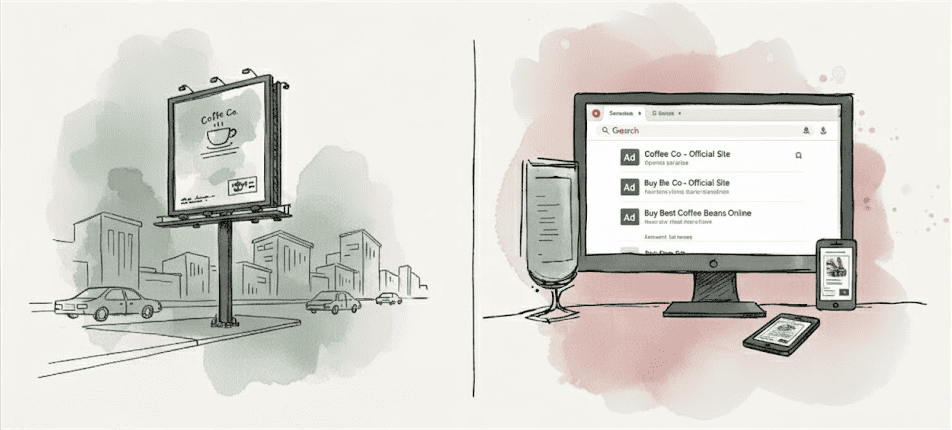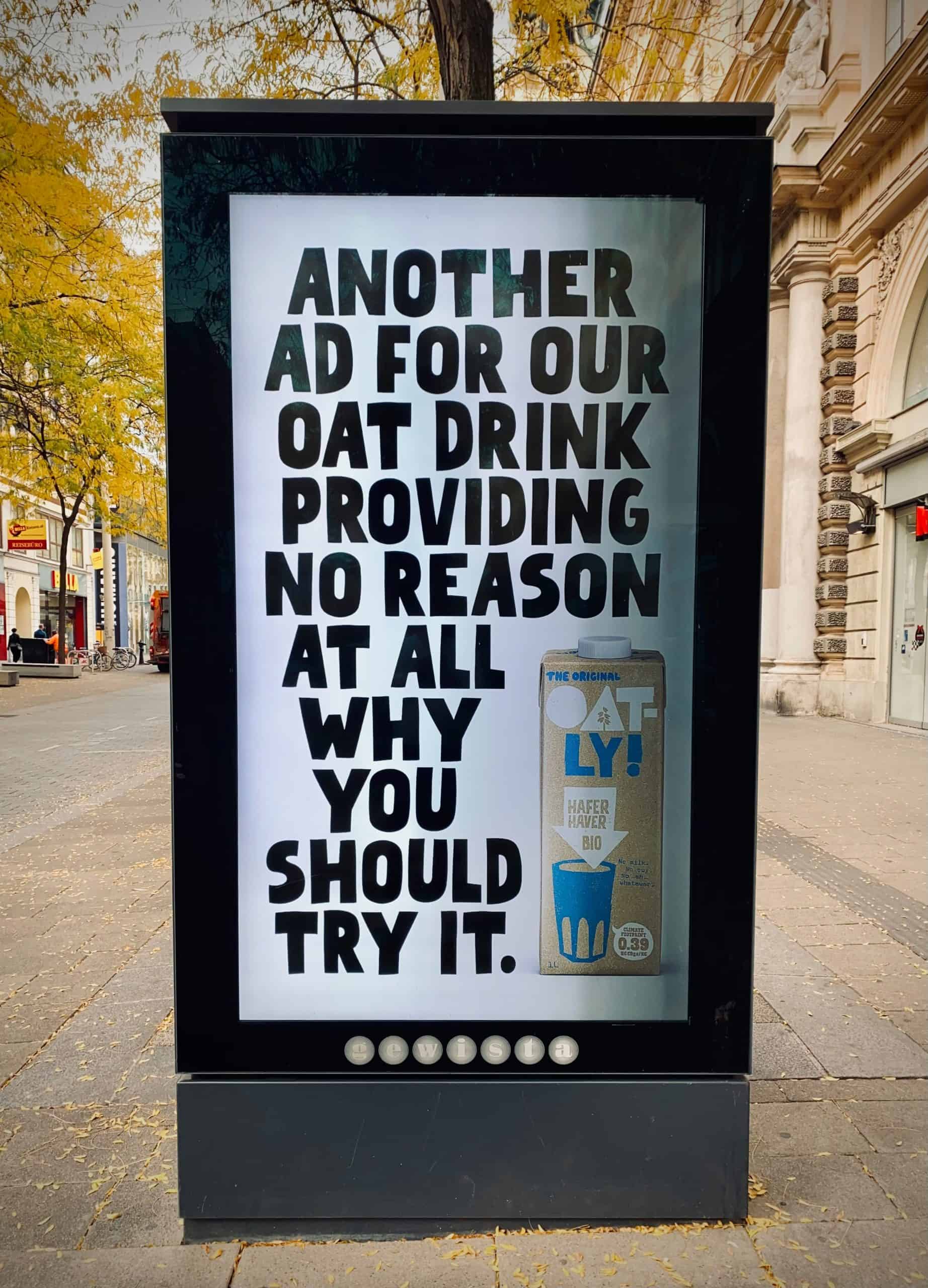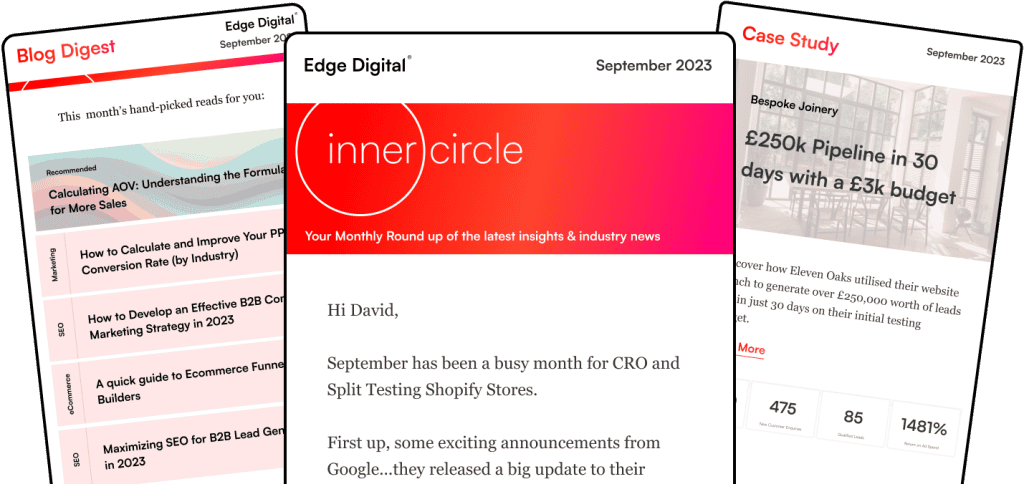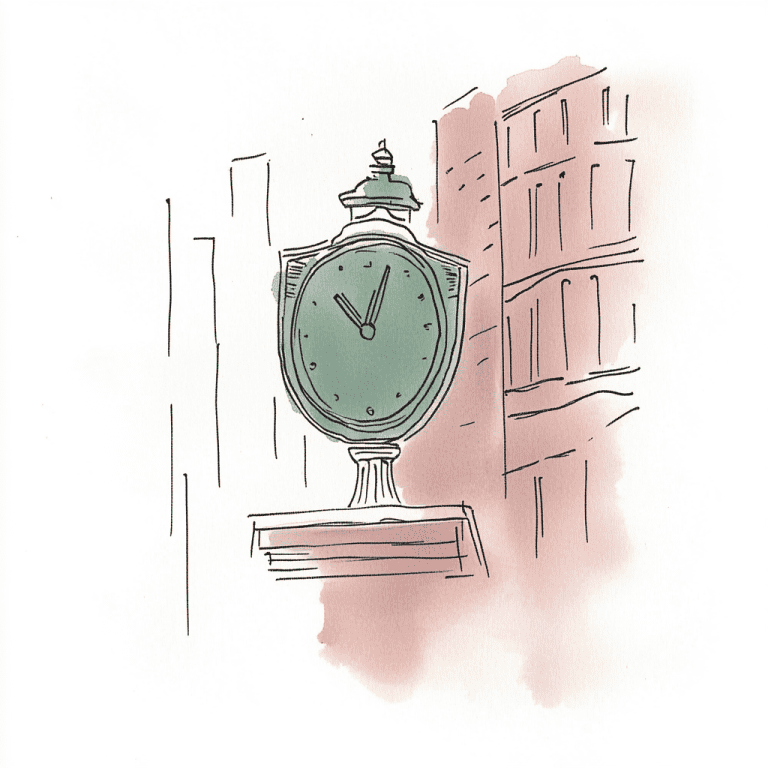When you’re deciding between billboards and Google Ads for your marketing strategy, it’s good to know that each has its own strengths. Billboards are awesome for building big brand awareness and making a visual impact, while Google Ads let you target specific people and track your results. In this blog we will dive into the billboards vs google ads pros and cons.

A smart move is often to use both—billboards get your brand out there, and Google Ads catch people when they’re ready to look you up online. This way, you cover all your bases.
Knowing how these two options differ helps you pick what fits your goals, budget, and audience. Let’s look at how they stack up on cost, reach, measurability, and brand building so you can figure out what’s best for your business.
Key Takeaways
- Billboards are great for broad brand awareness and visual impact, while Google Ads deliver targeted reach and measurable results.
- Combining both platforms creates enhanced ROI by bridging offline awareness with online intent.
- Your choice depends on your goals—billboards are better for building a brand, and Google Ads are perfect for direct response.
Fundamental Differences Between Billboards and Google Ads

Billboards work through physical placement and mass exposure, while Google Ads use digital targeting and search intent. They operate in totally different ways and have their own measurement systems.
Traditional vs Digital Advertising
Billboards are the OG of out-of-home advertising. You see them along roads, in city centers, and at transit stations.
Traditional advertising characteristics:
- Fixed location and timing
- Broad demographic reach
They don’t offer much interaction, and it’s tough to measure exactly how well they’re working.
Google Ads are part of the digital world. They show up in Google search results, on websites, and in apps.
Digital advertising features:
- Dynamic placement and scheduling
- Precise audience targeting
You also get interactive options and detailed performance tracking.
The key difference between traditional and digital is how they connect with people and how you measure their success.
How Billboards Work
Billboards reach people by being in the right physical spots with lots of foot or car traffic. You buy space for a set time, usually by the month.
Your ad is up 24/7 for anyone passing by. The location decides who sees it and how many people you’ll reach.
Billboard basics:
- Pick a spot with good traffic
- Design your ad for quick viewing
- Get it installed
- Let it run for your chosen period
They’re best for campaigns that want to boost brand awareness in a local area. You won’t be able to track who sees the ad or how many people actually take action.
Costs include making the ad, installing it, and monthly rent. Prime billboard spots can cost around £14,000 a month.
How Google Ads Operate
Google Ads run on an auction system where you bid on keywords. Your ads show up when someone searches those terms or visits related websites.
Placement depends on your bid, your ad’s quality, and how relevant it is. You only pay when someone clicks.
How Google Ads work:
- Keyword targeting for search queries
- Audience segmentation for user details
- Real-time bidding
- Performance tracking for conversions
Google Ads are awesome for catching people who are actively looking for what you offer. You get detailed stats on clicks, impressions, and conversions.
You can tweak your campaigns anytime based on what’s working. Digital ad spending keeps climbing as businesses want trackable results.
Costs vary, but average is around £2 per click, depending on your industry.
Reach and Target Audience
Billboards and Google Ads reach people in totally different ways. Billboards cast a wide net in specific spots, while Google Ads let you zero in on people based on their searches and demographics.
Audience Reach Capabilities
Billboards are all about big reach. Put one in a busy place, and thousands will see it every day.
Digital billboards are especially good for this. You can run a digital billboard campaign for as little as £20 a day, so even small businesses can get in on the action.
Google Ads, on the other hand, reach people based on what they’re searching for and their online habits. The audience might be smaller, but they’re usually more interested.
Billboards hit everyone in an area, even if they don’t care about your product. Google Ads connect you with people who are already interested.
Precise Targeting and Geographic Focus

Google Ads are super precise. You can target by age, income, interests, and even the exact keywords someone types in.
You can also target by postcode, city, or a certain distance from your business. This helps you spend your budget on the people who matter most.
Billboards are more about covering a whole area, not specific people. Digital billboards use traffic data to get the most eyes at the best times.
Local businesses love billboards for this. For example, a restaurant can reach everyone driving by, while a Google Ad will only show up to those searching for places to eat.
| Targeting Method | Billboards | Google Ads |
|---|---|---|
| Geographic Focus | Broad area coverage | Precise location targeting |
| Audience Selection | Everyone in location | Specific demographics |
| Intent Targeting | General exposure | Search-based intent |
High-Traffic Area Impact
High-traffic spots are where billboards shine. Think highways, city centers, and transit hubs—tons of people see your message every day.
Seeing the same billboard on a daily commute really helps with brand recognition. People remember what they see over and over.
Google Ads work well as a follow-up. Someone might see your billboard, then later search for you online and see your ad again.
Digital billboards in busy areas are extra handy because you can change your message at different times of day. Show one thing in the morning, something else at lunch, and another in the evening.
For local businesses, this combo is gold. Billboards get your name out there, and Google Ads catch people when they’re ready to take action.
Measurability and Return on Investment

Google Ads let you track everything in detail, while billboards are better for building brand awareness that’s harder to measure but still important.
Tracking Conversions and Engagement
Google Ads give you detailed conversion tracking. You’ll know which ads lead to sales, calls, or sign-ups.
You can see user behavior from start to finish and spot which ads and audiences work best.
Billboard tracking isn’t as exact, but it’s getting better. Modern LED billboards can measure real impressions instead of just guessing from traffic.
Still, you can’t track clicks or direct conversions from a billboard. You’ll need to use things like QR codes or special promo codes to get an idea of response.
Google Ads Tracking:
- Click-through rates
- Conversion rates
- Cost per acquisition
Billboard Tracking:
- Impression counts
- Brand recall surveys
- QR code or promo code usage
Real-Time Analytics
Google Ads give you real-time data. You can see what’s working and pause or change ads instantly.
You’ll get up-to-the-minute stats on impressions, clicks, and conversions. If something’s not working, you can swap it out fast.
Billboard data comes in slower, usually weekly or monthly. Once your ad is up, it stays for the whole contract—no quick changes.
Calculating ROI and Measurable Results
Google Ads make ROI easy to track. You see exactly what you spent and what you got back.
The platform calculates your return on ad spend (ROAS) automatically. Spend £100 and make £300? That’s a 3:1 return.
Billboard ROI is trickier. You have to factor in the value of people remembering your brand, not just direct sales.
Google Ads ROI Formula: Revenue Generated ÷ Advertising Cost = ROI Ratio
Typical Google Ads Metrics:
- Average ROI: 200-400%
- Click-through rates: 2-5%
- Conversion rates: 2-10%
Billboards usually have a lower cost per thousand impressions, but you’ll need a few months to really see results.
Brand Awareness and Experience
Billboards and Google Ads both help people remember your brand, but in different ways. Billboards keep your name front and center all the time, while Google Ads let you connect with people directly and interactively.
Using both builds a stronger brand presence through repeated exposure and meaningful engagement.
Building Top-of-Mind Awareness
Billboards are great for building top-of-mind awareness because people see them every day on their commutes and in busy areas. Most businesses start to notice results within 3 to 6 months after launching brand awareness campaigns.
Key advantages of billboards for awareness:
- 24/7 visibility that can’t be blocked
- Large format for memorable visuals
- Reaches people during their daily routines
Google Ads build awareness by showing your brand to targeted audiences through search and display. These campaigns focus on how well people remember seeing your brand after exposure.
Brand awareness campaigns can boost recall by up to 30% within three months when done right. Google Ads let you target by demographics, interests, and search habits.
The main difference is how people see your ads. Billboards create passive awareness through constant exposure, while Google Ads show up when people are actively searching for what you offer.
Establishing Brand Trust
Unlike online ads that people can skip or block, static billboards give your brand continuous exposure. This physical presence makes your business look established and credible.
Billboards help position your brand as an authority just by being out there for everyone to see. People often trust billboard advertisers more because of the investment involved.
Google Ads build trust in a different way. Relevant ads that answer search queries show your expertise and reliability. Features like reviews and business verification badges also boost credibility.
Trust-building elements in Google Ads:
- Customer testimonials and ratings
- Professional ad copy and landing pages
- Consistent brand messaging
- Transparent business info
Both billboards and Google Ads need consistent branding to build trust. Billboards offer broad credibility, while Google Ads deliver trust at the exact moment someone is looking for your services.
Brand Loyalty Through Multichannel Exposure
Combining billboards with Google Ads gives your brand multichannel exposure, which is huge for building loyalty. After 6-7 views, people start to recognize and engage with your ads, leading to more conversions.
Multichannel loyalty benefits:
- Reinforced messaging across channels
- Higher recognition and recall
- More chances for engagement
Billboards make people familiar with your brand, so when they see your Google Ads later, they’re more likely to click. Users who’ve seen billboard campaigns usually have higher engagement with digital ads.
Google Ads pick up where billboards leave off by capturing intent-driven searches. When people are ready to buy, they’ll remember your brand from the billboard.
You can even track this by looking at geofencing data around billboard locations to see if search activity and website visits go up. Using both channels together usually leads to better results than using just one.
Creative Impact and User Interaction
Billboards and Google Ads each have their own creative impact and ways people interact with them. Digital ads can get ignored (banner blindness), but billboards stand out thanks to their physical presence.
Visual Impact and Recall
Billboards make a big impression because of their size and placement in busy areas. Most of us see them daily, which helps build brand recognition through repetition.
Their scale lets you use bold, simple messages that are easy to process. That’s why billboards still have a strong presence in UK cities and along major roads.
Google Ads approach visual recall differently. Display ads are smaller and compete with other website content, while search ads are just text.
Billboard advantages:
- Huge visual impact
- Can’t be ignored in public spaces
- Daily repeated exposure
Google Ads advantages:
- Targeted visuals based on interests
- Dynamic creative options
- Multiple formats (text, image, video)
Engagement Through Digital Features
Digital billboards now use things like QR codes to connect offline ads with online actions. QR codes make it easy for people to visit your website or promo page.
Traditional billboards don’t offer much direct interaction beyond just seeing them. Digital billboards can switch up their content based on time or weather.
Google Ads shine when it comes to engagement. People can click, call, buy, or download right from the ad.
Interactive features include:
- Billboards: QR codes, digital displays, location-based content
- Google Ads: Click-to-call, shopping features, app downloads, lead forms
With Google Ads, you get detailed engagement data like clicks and conversions. Billboards are harder to measure for direct engagement.
Ad Fatigue and Banner Blindness
Banner blindness is a real issue for digital ads—people just tune them out on websites. We’re all used to ignoring banners in the same spots online.
Display ads often struggle to get attention, and ad fatigue sets in when people see the same ads everywhere. Users can even block digital ads altogether.
Billboards don’t have the same problem since you can’t “block” them in real life. But over time, commuters might start to mentally filter out familiar billboard spots.
Digital ad fatigue factors:
- Seeing the same ads everywhere
- Similar creative formats
- Intrusive placements
- Ad blockers
Billboards keep things fresh with creative rotation and by being in different locations. Exposure depends on where people travel, not just online behavior.
Cost, Flexibility, and Practical Considerations
When you compare billboards and Google Ads, it’s important to look at costs, ongoing expenses, and how flexible your campaigns can be. Each has its own pros and cons for local businesses.
Budgeting and Cost Effectiveness
Billboard campaigns need a bigger upfront investment. Renting a good location can cost thousands of pounds a month, plus design and production.
Traditional billboards can still be cost-effective if you want long-term brand presence. The fixed monthly cost makes budgeting easier.
Google Ads use a pay-per-click model, so you can start small and scale up as you see results.
Cost Comparison:
- Billboards: £2,000-£10,000+ per month
- Google Ads: £500+ per month, flexible daily budgets
- Setup: Billboards need design/printing; Google Ads need minimal setup
Digital billboards cost more because of their dynamic content, but you can sometimes share space with other advertisers to save money.
With Google Ads, you can track your ROI and adjust your budget as needed.
Campaign Flexibility and Speed
Google Ads can launch within hours, and you can tweak targeting, budgets, and messaging anytime.
Billboard campaigns take weeks or months to plan, and once they’re up, you can’t change them easily.
Flexibility Features:
- Google Ads: Instant edits, A/B testing, audience tweaks
- Billboards: Fixed messaging, only seasonal changes
Digital campaigns let you target specific audiences no matter where they are. Billboards are limited to their physical location.
Digital billboards are more flexible than traditional ones since you can update content quickly, but they’re still tied to a location.
With Google Ads, you can pause or resume campaigns instantly. Billboards usually require a minimum contract of one to twelve months.
Local Business Implications
Using both billboards and Google Ads is a strong combo for local businesses. Billboards build awareness, and Google Ads capture search intent from people who’ve seen your billboard.
Billboards work best in high-traffic areas where your customers live and work. Their strength is reaching people in a specific geographic area.
Google Ads are great for targeting local searches, so when someone looks you up after seeing your billboard, you can appear right away.
Local Business Considerations:
- Service areas: Billboards are ideal for businesses serving certain regions
- Competition: Google Ads can be competitive for local keywords
- Brand recognition: Billboards help you look credible in the community
Social media ads and billboards play different roles. Billboards reach a wide audience, while digital campaigns let you target specific customers.
How you split your budget depends on your goals. New businesses might focus on Google Ads for quick leads, while established ones use billboards for long-term presence.
Integrating Billboards and Google Ads for Optimal Results
Combining billboards with Google Ads gives you the best of both worlds, reaching people at multiple points in their journey. This approach boosts brand recognition and captures people when they’re ready to act.
Multi-Channel Customer Journey
People interact with brands across different channels before making a purchase. It’s important to plan out these touchpoints.
A typical journey:
- First notice your brand on a billboard
- Do some online research after seeing the ad
- Hit several digital touchpoints before buying
Billboards kick off the process by creating awareness. When someone sees your billboard, they might search for you online later.
Google Ads are perfect for capturing this intent. You can target branded keywords and local searches to connect with people who saw your billboard.
Key integration tactics:
- Add QR codes to billboards that link to landing pages
- Use unique hashtags for billboard campaigns
- Make special landing pages for billboard traffic
- Target branded search terms in Google Ads
Keeping your messaging consistent across both channels helps build trust and keeps your brand top of mind.
Synergies Across Online and Offline Channels
The real magic happens when these channels work together. Billboards give you mass reach, and Google Ads let you target and measure results.
Billboard strengths:
- High visibility in local areas
- 24/7 exposure
- Builds a strong local presence
- Emotional impact through visuals
Google Ads strengths:
- Pinpoint targeting
- Real-time tweaks
- Detailed performance tracking
- Cost-effective reach for specific groups
Combining these, you get broad awareness from billboards and targeted action from Google Ads.
You can track how billboards affect your digital performance by using unique URLs, promo codes, or tracking pixels.
Measurement techniques:
- Watch for spikes in branded searches
- Track website visits after billboard launches
- Use custom landing page links
- Check conversion rates
This data helps you make smarter decisions and get better results from both channels.
Future Trends in Advertising Integration
Technology is making it easier to connect billboards with digital marketing. New tools help link offline exposure with online engagement.
Emerging technologies:
- Programmatic digital billboards that sync with online ads
- Geofencing to trigger mobile ads near billboards
- AI for audience matching across channels
- Real-time creative updates based on performance
Programmatic buying is coming to outdoor ads, letting you adjust digital billboard space automatically based on your Google Ads data.
Location-based targeting is getting smarter—when someone passes your billboard, you can show them a mobile ad soon after.
Advanced integration strategies:
- Dynamic creative updates across channels
- Cross-channel attribution modeling
- Automated budget shifts between billboard and digital
- Personalized retargeting after billboard exposure
We’re heading toward seamless integration, where every billboard view can be followed up with a personalized digital ad. This will make your campaigns more effective and much easier to measure.
Frequently Asked Questions
Business owners have lots of questions about costs, targeting, and how well different ads perform. Things like how ads fit into your overall plan and what creative limits you’ll run into also matter.
What are the key differences in audience targeting between billboards and online advertising platforms like Google Ads?
Google Ads lets you target specific demographics like age, income, interests, and online behavior. You can reach people anywhere in the world.
Billboards focus on local geographic targeting. Digital billboards can even show different ads at different times of day, like during rush hour or lunchtime.
With Google Ads, you can exclude people who aren’t interested in your products. Billboards, on the other hand, are seen by everyone passing by, whether they care about your brand or not.
Online platforms use user data to get better at targeting over time. Billboards rely more on where they’re placed and local traffic patterns.
How do costs compare when investing in billboard advertising versus Google Ads campaigns?
The average cost for a billboard in a busy area is about £14,000 per month, while Google Ads usually costs around £2 per click.
Billboard costs stay the same no matter how many people see your ad. Google Ads costs go up with each click, so it can be tough to predict your budget.
Digital billboards give you a big local reach for a set price. You’re paying for guaranteed impressions instead of hoping people will click.
Google Ads need regular tweaking and management. Once your billboard is up and running, there’s not much maintenance involved.
What metrics should be considered to measure the effectiveness of billboard advertising against Google Ads?
Google Ads gives you detailed stats like click-through rates, conversions, and cost per acquisition. You can see exactly what’s happening with your campaign.
Billboards can use things like hashtags, unique URLs, or QR codes to help track engagement and offline actions.
Impressions are measured differently on each platform. Google Ads counts when someone sees your ad online, while billboards estimate views based on local traffic.
Brand awareness surveys work well for measuring billboard impact. Google Ads is better for tracking direct responses and conversions.
Can billboard advertising and Google Ads be effectively integrated in a cross-platform marketing strategy?
Combining both platforms can be super effective. Someone might see your billboard on their commute, then get retargeted by your ad online later.
This combo reinforces your message and can boost conversion rates. Billboards help people remember your brand, and Google Ads can capture that interest when they’re online.
Local businesses especially can benefit from running coordinated campaigns. Use billboards to get your name out there, and Google Ads to target and track conversions.
How does the reach and frequency of exposure vary between billboard advertising and Google Ads?
Google Ads can reach anyone online, anywhere. But things like ad blockers and banner blindness mean not everyone will actually see your ad.
A good billboard guarantees thousands of real people in a specific area see your message daily. Local traffic patterns make exposure steady and predictable.
People often scroll past online ads quickly. Drivers might see your billboard for 10 seconds or more while sitting in traffic.
Billboards build frequency by being seen on daily commutes. With Google Ads, you need to watch your budget to avoid showing the same ad too often.
What are the creative constraints and opportunities unique to billboards as opposed to Google Ads?
Billboards require simple, bold messages that people can read while driving by at high speeds. Text has to be minimal and super visible from far away.
You’ll want to use high-contrast colors and big fonts when designing for a billboard. There’s no room for lots of details or small print.
Google Ads, on the other hand, let you share more detailed info about your product. You can use multiple images, longer descriptions, and interactive features.
With Google Ads, you can include clear calls-to-action and make it easy for people to click and buy right away.



